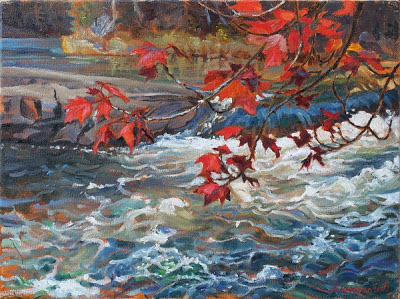Visit to a Hemlock (oil on canvas 5 x 7 in.) Sold
5 January finds me on a snowy forest road, walking toward a Sugar bush I was told about, just off Gravel Hill Road north of Monkland, Ontario. I've stopped to paint less than a kilometre in from the red gate, because the sun will set soon. My painting gear and my cushion, blanket, and ground sheet are all piled into a plastic recycling box to pull it behind me like a sled. Deer tracks precede me, the toes punched deeply into the snow and the dew claws making two pointed marks behind each print.
Close to the left hand side of the forest road a tall Hemlock about 50 cm across leans a little toward a younger tree and the two seem to be in silent dialog. A squirrel has left its tracks about the base of the larger tree, and drifted snow picks out the pattern of its grooved bark. Looking up I see broken stubs of branches to half the tree's height, and then a healthy, finely needled, forked crown, broken off bluntly at about 20 metres.
Sitting on the overturned box I spread my blanket across my lap, tuck it around my legs, and begin to paint - this one needs a rich burnt sienna underpainting. Though the forest is young here, and mostly Maples, it is presided over by scattered old Hemlocks, their trunks massive in contrast with the slim Maples' grey bark.
As I work, Chickadees are busy, flitting and peeping in the shadowy copse of young Hemlocks behind me, finding tidbits that they hid in crevices last summer. That's a lot of hiding places to store in their tiny clever brains - but Chickadees only retain the memories of their food caches for one year. Research has shown that each spring they start with a clean slate!
As dusk falls and I pack up, I'm more aware of the rushing of the highway as it echoes beyond the dark conifers to the northwest. Earlier the flaming sunset glinted like blown embers between their trunks from across open land. I glance up as I turn to go, at the moon peeking owlishly from between dark Hemlock boughs as it rises in the east, early full. The forest track is broad and white and easy to follow in the growing dark and I avoid taking wrong turns by retracing the faint drag mark of my box sled back to the van.
This is the S.E corner of the "old sugar bush" owned by South Nation Conservation since 1966. I've been told that only the stumps of the mature sugar maples remain along with the sugar shack; a new succession of 30-40 year old sugar maple, hickory, white ash dominates the natural forest. This is an upland forest situated on the bouldery phase of the Eamer soil series and likely marginal for agricultural purposes. The numerous stone fences that divide the property into 10-acre fields are evidence of the effort that was expended in the attempt to cultivate the land. The property was one of the early acquisitions of SNC and the cropped areas were planted to White Pine, White Spruce and Jack Pine.
When Fred was young, the ecology texts envisioned the eastern North American forest coming to a steady state climax of shade-tolerant Hemlock Tsuga canadensis), Beech (Fagus grandifolia), and Sugar Maple (Acer saccharum), and he wrote youthful poems about the stability of these forests. The deforestation of eastern Ontario in the 19th century was so complete, pests and diseases introduced from Europe so stressful, and the approaching climate change so overwhelming, that there's no way we're going to be able to look forward to stable climax forests within the next century.
Aleta
Aleta




Comments
Post a Comment
What do you think of this painting, and what do you know about the subject that I have painted?